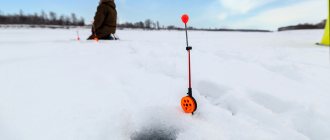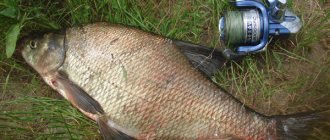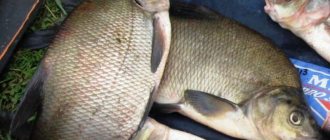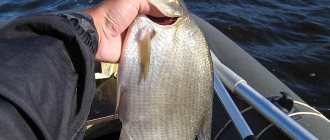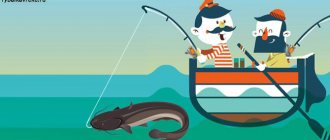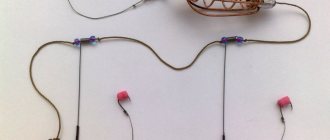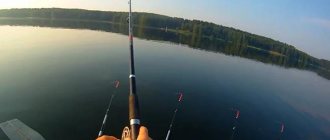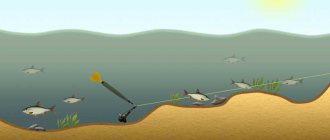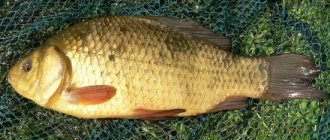Mesh product
Metal wire is an ideal solution for making your own fishing feeder.
If desired, suitable canvases for the job can be found at points of sale of building materials. How to make a fishing feeder from a metal mesh? First of all, you need to have a sufficient piece of material, a small piece of lead, and also have scissors on hand.
First, a piece of the required size is cut out from a piece of mesh. Next, a strip of lead is cut to serve as a crimp for the edges of the pyramidal or cylindrical structure. Finally, a wire fastening is formed to connect the finished product to the fishing line.
Access equipment
The undercutting tackle in the form of the above-mentioned “ring” requires more powerful equipment in the form of a nylon cord for the feeder, the main fishing line and undergrowth as an undergrowth. The cord can be of any diameter, but should not cut your hands, since the feeder weighs almost as much as a bucket filled with bait. The diameter of the main line is 0.4 mm, the leader line is 0.3 mm, the leaders are 0.2 mm. Hook size – No. 10-8 international numbering. The “donkey jar” rig can be a little more miniature. For fishing from a boat with a ring and a can, side rods with fairly rigid guards made of spring wire or a flat spring are used. Coils can be wired or inertialess, whichever is more convenient.
Reels
The best choice would be an inertia-free, rear-friction reel. A beginner can be advised to take a cheap Chinese reel for the first time, the main thing is that it winds the line evenly, does not interfere with its free flow when casting, and does not throw out beards.
But if finances allow, then it is better to immediately spend money on a good one, even if not from branded manufacturers. If, for some reason, you decide to take an inertial drum reel, then you should take a closer look at the “unkillable” salmon.
Bottle fishing feeder
An ideal option for catching bottom fish (carp, carp, catfish, bream), which prefer to look for food in the ground, would be a model known as a “nipple”. Such a fishing feeder can easily be made from a cork from a drinking water container. To complete the work, you only need a plastic base, a piece of lead, a winding ring, and a hole punch in the form of a nail or an awl.
First, a flat sinker is placed at the bottom of the cork, which can be made from sheet metal. To fix the weighting agent, it is enough to make through holes in the product, into which a strong, pliable wire is inserted and twisted inside. Using any suitable hole punch, openings are prepared on the walls of the cork for a wire ring, leashes and hooks.
In conclusion, all that remains is to prepare bait with a viscous consistency that will hold well in the existing current, fill the “nipple” with it and hide the hooks in the bait.
Tackle ring
The method of ring fishing refers to one of the varieties of bottom fishing. The presented type of donkey for bream is assembled with your own hands. Ring fishing is considered a catch method, since its principle is based on the constant point-by-point attachment of a trophy to the hunting zone with large volumes of bait. The bait is fed into a trail of turbidity formed from the washout of the food, thus significantly increasing the likelihood of a quick and effective bite.
Important! The ring tackle is used when fishing from a boat.
For the equipment, side fishing rods with monofilament with a diameter of 0.25 to 0.30 mm are used, at the end of which leashes are placed a meter long and about 0.15 mm thick. The feeding train is organized using a feeder with loading, which can even be a mesh bag with a stone loaded with bait. The feeder is lowered to the bottom just under the boat using a 0.4 -0.5 mm fishing line tied to the bow of the craft.
The key point of the method is the winding ring, made with cuts according to a certain method from lead or steel weighing no more than 50 grams. The ring, placed on the main line and the fishing line from the feeder, accurately delivers the leash with the hook and bait into the zone of the bait train, which stimulates and, by and large, guarantees a stable bite. A ring is a tackle for catching bream in the current, used in open water from early spring until freeze-up.
What to choose: fishing line or braided cord?
How to figure out what to choose: fishing line or cord? You need to understand their fundamental differences. The fishing line is basically a regular nylon thread.
The main characteristics of the fishing line are thickness and tensile strength. The thicker the line, the more weight of the fish it can support.
The optimal fishing line thickness for bottom fishing is 0.25 – 0.40 mm. Such parameters do not have the best effect on air resistance, which is important in windy weather, and water resistance, which is important in the presence of even a slight current.
Braided cord is more expensive than fishing line, but it is more convenient when used in bottom fishing.
The cord has no memory and does not stretch, which makes hooking much easier. With a smaller thickness, it has greater strength, which significantly reduces the resistance of water and air. The casting distance increases. Braid with a thickness of 0.20 - 0.28 mm is suitable; this is enough to catch the strongest and most lively bream.
Curler feeder
You can make effective equipment from ordinary plastic hair curling accessories. Thanks to the variety of ready-made, available options, such a do-it-yourself fishing feeder can be made in any color and shape. To change the size of the product, you only need to apply a minimum of effort. It is convenient to carry out the work with pliers and wire cutters.
When choosing a suitable base for making the desired design, you should not give preference to curlers made of unreliable material, as well as options with a pronounced, repulsive odor.
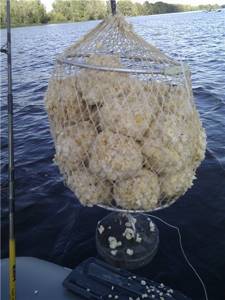
To make the product heavier and stronger, as in previous cases, the edges are crimped with a piece of lead plate.
Alternative tackle
Alternative gear includes types of fishing borrowed from the methods of catching other peaceful fish and, in particular, crucian carp and carp. These methods help to effectively replace the classic donkey for catching bream, taking into account the specific behavior and changes in the diet of the fish, as well as the fishing season. The fishing technology itself, as well as the design features of the equipment, do not differ much from the original versions of the rigs. In the vast majority of cases, the differences are only in the composition of the bait mixtures and the weight of the loads that can hold the equipment in faster currents. Catching bream on a donk using alternative methods, under some conditions, will have advantages over the usual classic gear.
Makushatnik
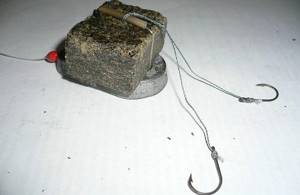
A spinning rod with a medium or semi-fast action is equipped with a spinning rod, mounting a bait platform on braided cords. They use gear for catching bream in the summer from the shore at night. The principle of operation of the makushatnik is based on the fish sucking a strong-smelling bait with the swallowing of empty hooks embedded in the briquette of the makushat. For leashes, a monofilament line with a thickness of 0.2 mm and a length of no more than 10 cm is used. From two to six hooks are placed on the crown.
Pacifier
The principle of operation of the nipple is similar to the principle of fly fishing, only instead of a compressed briquette, plastic bait is used, placed in an open feeder or pressed into the coils of a spring. The effectiveness of attachment depends on the type of attractant used in the bait mixture. The right scent promises rich catches. As in the makushatnik, bare hooks on short fishing line leashes are introduced into complementary feeding.
Zakidushka
They begin to catch bream on a donk in the form of a bait immediately after the ice melts, using the method until the fish leave for the wintering pits. For the basis of baits, spinning rods of medium and even slow action are used. The weight of the sinker promotes self-hooking of the fish, and the shock-absorbing properties of the rod provide reliability when fishing for a large trophy. The rod is equipped with an inertia-free reel with braid, at the end of which a rig of a blind sinker and a leash with a hook is knitted. In case of weak bite, a feeder is mounted on the bottom, thereby additionally attracting fish with food.
Rubber

An elastic band is a modernized type of classic cord bottom. Installing a bottom tackle with an elastic band does not require re-casting, which does not scare away wary fish. The gear is assembled by adding a shock-absorbing rubber band to the frame, installed between the main line and the load. Due to the design features and the method of supplying the rubber band to the fishing zone, when the load is installed from the boat, it can have a significant length, expressed in a hundred or even more meters. The gear is convenient for catching bream in the fall on the eve of winter, when the fish becomes passive and the effectiveness of fishing is achieved by the large-scale use of a variety of baits, the size of the fished area and the noiselessness of casting the gear.
Choice of bait
We can talk a lot about hooks, but for catching bream, any that meet the following characteristics are suitable. The hook must first of all be sharp, capable of not becoming dull for quite a long time.
Constantly check its sharpness on the nail, run the tip along the nail; if the hook picks up the nail, it is sharp enough and slides over it without hindrance, which means it needs to be sharpened with the smallest needle file, or replaced with a new one.
The thickness and size of the hook must be taken into account based on what bait you will use. The smaller the bait, the smaller and thinner the hook for it. But remember, a hook that is too small may bend the fish or fall off it.
Too thick and large, they may scare away wary bream. By varying the size of the hook, you can achieve the optimal value, at which a fish that is too small will not be able to swallow it, and a large fish will not break off. A real fisherman always has several sets of hooks in stock.
The success of fishing largely depends on the choice of bait. Its composition must be of the required consistency so that when the rod is sharply hooked, the mixture creates the appearance of a cloud and spreads a pleasant smell, which will definitely attract fish. The bait should consist of both small elements and larger grains.
The bait consists of:
- bulk;
- filler;
- flavoring
There is one more important point. It also concerns the device of the tackle.
The fact is that the number and length of leashes for carp equipment with a feeder can be different. What does this depend on? It’s just that a number of anglers prefer to use one long leash.
Thus, the design of the gear becomes almost identical to the feeder. Others, on the contrary, equip the equipment with a feeder with several short leashes.
In this version, it resembles a “pacifier” in design.
However, carp fishermen prefer gear that has a feeder with one hook. Moreover, such equipment must have a long leash. On average - from 50 to 100 cm.
Only a few people fish with a rig with a feeder and several leashes. Why? There are the following reasons for this:
- Carp rigs with a feeder, which are equipped with two or three leashes, are more susceptible to snags, tangling and line overlaps. All this can lead to the fact that instead of fishing, you will have to re-install the gear.
- Rigs with multiple hooks require the installation of short leaders. Again, so that when casting and retrieving the line does not get too tangled. But all this can negatively affect the bite. After all, the shorter the leashes, the closer the bait is to the sinker, which cautious carp are often afraid of.
Therefore, when fishing with gear with a feeder, it is best to limit yourself to one hook (unless it is a “nipple”). In this case, you can put a fairly long leash.
As a result, when biting, the fish will not feel the resistance of the load and equipment, and, therefore, will take the bait more actively and boldly. And the risk that the line will get caught or tangled when casting or retrieving is minimal.
How to catch bream?
From shore to feeder
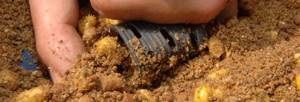
The feeder is considered one of the best gear for bream (we recommend that you study our guide to feeder fishing for bream in its entirety). It gives good results in both still and running water over long and short distances. In essence, the feeder is an improved donkey. The main difference is that the feeder is not equipped with a simple sinker, but with a feeder weight. There are various options for equipment: from the simplest, with an anti-twist tube, to the popular Gardner equipment (also called Paternoster). How to arrange it will become clear to you from the figure:

A fishing rod for feeder fishing is selected based on the width of the reservoir, fishing depth and current strength:
- heavy class for 70 m casting, suitable for deep areas with strong currents;
- medium class for 30 – 40 meters, for gentle currents and standing water;
The rod length is standard 3.9-4.2 meters. For longer casts, choose a longer rod; for fishing at close range or on an overgrown bank, you can get by with a 2.7-3 m rod.
The feeder reel should be of moderate power, up to 3000 - 4000 and with a gear ratio of 4.6-5:1.
fishing line
- Braid when fishing on soft ground. Thickness 0.1-0.13 mm. This line is more sensitive to bites, but cannot be used when fishing on a rocky bottom, as it wears out and gets damaged. We recommend Salmo Braid Elite.
- monofilament when fishing on rocky ground. Thickness 0.2-0.25. The sensitivity of high-quality fishing lines is also quite high. We recommend Salmo Feederist.
And for the leash - 0.18 mm monofilament or 0.25 fluorocarbon (it holds loads worse, but is invisible in the water). Take large hooks from 10 to 14 numbers. Their size depends on the nozzle. Catching bream in the current requires stronger and coarser tackle, a heavy feeder and dense bait with a viscous consistency.
Choosing a location. The most catchy places on the river bottom are considered to be holes, especially their edges and long underwater terraces. It is in these places that the river delivers a lot of food, and it is there that the fish feel more or less safe. If you do not have the opportunity to study the underwater terrain, then simply choose a calm place under a steep bank, get a little higher, where it is no longer so deep, and cast.
The process of fishing with a feeder itself consists of many casts as accurately as possible to the same place (the feeding technique is described in the link in the guide above). Fill the feeder with bait and throw. Do not wait long for a bite: no more than 3 – 10 minutes (only in autumn you can double the waiting time due to the lethargy of the bream). During this time, the food should be washed out of the feeder. Pull it out and make the next cast.
Night fishing for bream with a feeder
As is known in the heat of summer, bream mainly feeds at night.
In addition, at night it rises much closer to the surface. You can start a couple of hours before sunset: just enough time to look around, determine the bottom topography, prepare bait, and set up tackle. When fishing, use fireflies attached to the tip of your rod to sense fish bites. A couple of rods equipped with feeders in a good position will be enough to keep you going all night. At first, the silver bream and small bream usually bite, but after dark you need to wait for bites from large fish.
The largest trophies are caught from 2 am until the morning.
When choosing a place, remember that at night the bream moves closer to the shore than during the day. Choose places with an open sandy bottom, with a minimum of vegetation so that it does not cling to the equipment.
Just like during the day, don't make noise. For lighting, you can use a headlamp with LEDs. Night fishing is technically not much different from daytime feeder fishing. But it is more productive, and for many fishermen more interesting.
How to make a rig with a feeder for carp
In the manufacture of bottom tackle, the main role is played by the sinker; it determines the casting distance, fixation of the tackle on the bottom, and the ease of its removal. The heavier the sinker, the farther the tackle will fly, but keep in mind that the weight should not conflict with the test of the rod, the technical data of the reel, and the diameter of the fishing line or braided cord.
There are quite a lot of types of equipment. Conventionally, they can be divided into equipment with and without feeders.
To make bottom tackle without using a feeder, you need to take a sinker of the required weight, tie it to the end of a fishing line or braided cord, attach a leash with a hook above the load, it is possible to use several leashes. The leashes must be installed at such a distance that when casting they do not overlap each other.
And here's what you need to know: Rods and tackle for bottom fishing
Options are also possible when one leash is attached below the sinker, and the second above. To prevent twists and overlaps, you can use anti-twisters and rocker arms; you can make them yourself, or you can buy them in a store.
The disadvantage of this kind of tackle is that the bait must be thrown separately, and there is no guarantee that it will hit exactly the place you need, it can be carried away by the current, and it will not roll down significantly below the location of the tackle.
The fishing process is greatly facilitated by a tackle with a feeder, which is mounted on a fishing line. A feeder is made from wire, which is wound in the shape of a spring, and the edges are filled with lead. There are many options for making feeders, including the use of plastic bags. The idea of using a feeder is to deliver your complementary food precisely to the fishing spot.
The feeder can be mounted directly on the main fishing line, or secured with a leash. The latter option is less desirable; it complicates the tackle and increases the possibility of twisting.
It is more expedient to make sliding feeders, limiting the range of their movement along the fishing line with stoppers in the form of beads, or any other. You can combine the feeder with a sinker by melting a lead weight of the weight you need and pour it into the feeder.
Lately, the hedgehog tackle has been gaining popularity. To make it, you will need: a feeder with a sinker inserted inside or soldered into it, leashes tied to the edges of the feeder, of which there must be at least six pieces.
To prevent the leashes from twisting, they can be made from a stiffer fishing line, or heat-shrinkable tubes can be used. Attaching to a fishing line is best done using swivels.
If you don’t have the time or desire to make the equipment yourself, you can buy one ready-made in a store.
Bream lives in almost every body of water and is a rather shy and cautious fish. As a rule, bottom gear is used to catch it; they allow fishing equally fruitfully both from the shore and from a boat, are ideal for long casts, and most importantly, with the help of them you can catch a very large specimen.
Such gear is used when it is necessary to fish at depth, in strong winds, rain and other conditions.
The following bottom gear is used to catch bream:
- Rubber bottom - used if the bottom of the reservoir is very muddy or casts are made where there is a lot of vegetation. The only negative is that it is quite problematic to remove the gum from the water.
- A casting donka is ideal for large rivers or lakes; you can easily make long casts.
- Feeder - suitable for any depth, is a more universal tackle, which, due to its flexible top, allows you not to miss a bite. You can catch heavier specimens on the feeder.
The correct set of bottom gear is the key to a rich catch.
The package includes the following steps:
- Assembling the rod and installing the reel. To do this, you need to assemble all the elements, and, most importantly, fix the coil well. Tip: the pass rings must be on the same line.
- Pass the fishing line through the rings and make a knot at one end. Then attach the fishing line to the spool.
- Place a sliding sinker on the fishing line.
- Attach a leash. It is better to use more than one leash.
When bottom fishing for bream, any tackle must meet certain requirements:
- The length should be from 1 to 3 meters, depending on the nature of the reservoir and fishing conditions. It is noted that fishing is also possible with longer options, especially in large bodies of water.
- Medium density.
- Excellent for practicing all the jerks of the bream.
- Be comfortable for the fisherman.
Note: basically, bream weighing from 1 to 3 kilograms are caught on the donk; in rare cases, fish weighing 5 kilograms are caught.
It is better not to use telescopic rods; it is noted that they do not have the sensitivity required for fishing.
An interesting point: the donka for bream has been the most common tackle for decades.
The equipment for the bottom fishing rod should be as follows:
- The reel is a key requirement for free casting and smooth winding of the line;
- Fishing line - the best thickness is from 0.2 to 0.4 millimeters, choose a shade as close as possible to the color of the water in the river or lake. It is better to give preference to a braided cord; it is more durable and can withstand current speed better, plus it is indispensable for long casts. The ideal size is from 0.2 to 0.25 millimeters.
- Hooks – choose the sharpest ones, preferably double or single. If the bait is supposed to be small, then a small hook should be used, and vice versa. It is recommended not to use hooks that are too small; the bream can easily break off.
- Sinker - the choice is made based on the strength of the current, wind and casting distance; the more difficult the conditions, the more weight is needed, and vice versa.
- Feeders (you can do without them) - it’s better to take the open type.
Groundbait and bait
Features of bait for bream:
- For large individuals, make bait with the addition of large particles. Otherwise, other inhabitants of the reservoir may eat it.
- For low-weight fish, everything needs to be chopped as much as possible.
- You should not overfeed bream.
- If the bait is thrown manually, then you need to do it so that some of the lumps scatter when they hit the surface of the water, and some fall to the bottom.
- The feed should be washed out easily.
- Add flavors (especially artificial ones) very carefully; if you overdo it, the fish may not be interested at all.
- The ingredients used are those that are the usual food for bream.
Note: you can buy ready-made bait in stores, but it’s better to make it yourself.
To make bait you need to take:
- cereal - this is the basis. It is better to use pearl barley or millet. In many regions, this fish prefers steamed peas.
- breadcrumbs;
- corn;
- worms;
- bloodworms (or maggots);
First, let's look at what options for such equipment exist. All carp equipment with a feeder can be divided into 2 types:
- self-clipping;
- sliding.
The first type includes those equipment in which the feeders (and they often come with a built-in load) are fixedly fixed. As a result, when fishing with this type of gear, carp hook themselves in 40-50% of cases. The second type is equipment with a sliding (moving) load. Their main advantage is that the fish feels minimal resistance when biting, as a result of which they are more willing to swallow the bait.
Which of these equipment options is better? It’s impossible to say for sure. Each of them can be more effective in certain conditions. Therefore, when choosing between self-cutting and sliding equipment, pay attention to:
- flow (its presence/absence);
- bottom relief;
- the nature of the soil at the fishing site (silt, sand, pebbles, etc.);
- weather.
It is also worth considering the behavioral characteristics of the fish. If the carp behaves inactively or cautiously, then the option with a sliding feeder-weight will be preferable. And, conversely, when there are a lot of bites, but it is not possible to hook a fish, it is better to opt for “deaf” equipment.
As for the feeders themselves, which are used in carp fishing, there are a huge number of them. They all differ in their design and shape. This was not done by chance - each model is better suited for a particular gear, more adapted to a specific bottom topography, bait, etc.
And here's what you need to know: Basics of feeder fishing in rivers for beginner anglers. Part 5. Tactics and technique of feeder fishing
At the same time, feeders are mainly used when fishing for carp:
- semi-closed and open type;
- springs;
- frame;
- latticework (“cells”);
- “tunnels”, “curlers”, etc.
“Method” feeders are also in particular demand among carp fishermen. They do not sink into the muddy bottom and have good flight characteristics that increase casting range.
There are a lot of installation methods. Therefore, for every angler there are several options for making equipment with a feeder to choose from. Which one is better and more suitable for you can be determined in practice - literally after 2-3 fishing trips.
We, like many professional carp fishers, recommend installing equipment with a feeder as follows:
- A leash with a hook is made from fluorocarbon. Its length is from 10 cm to 1 m.
- Next, take a feeder feeder (or a method feeder). A monofilament or cord is inserted through it.
- A swivel is tied to the end of the main line. The movement of the feeder can also be limited by the upper stopper.
- A pre-prepared fluorocarbon leash is tied to the free eye of the swivel.
- If necessary, you can add additional weight. For example, several lead pellets along the entire length of the fishing line.
So a simple carp version of the equipment with a feeder is ready. At the same time, it can be modernized in every possible way. For example, many fishermen use an anti-twist agent, which helps avoid overlapping and tangling of the fishing line. However, it makes the rig more noticeable, which can negatively affect the bite.
Winter fishing for river bream and roach on the current
Rolling effectively catches fish in the current, where fishing with other gear can be difficult or even impossible. Schools of bream, roach and other whitefish on rivers in winter often feed in deep places with a constant current. They are the main catch of the fisherman when using the skating rink.
The technique of skating fishing does not require any complex or sophisticated gear, it is quite simple, easy to master even for a novice fisherman, but at the same time it is rewarding and interesting.
Choosing a place for fishing
In order to effectively catch carp fish in the winter, you need to calculate their parking and feeding places. If the river where you plan to fish is unfamiliar, it is advisable to talk in advance with local fishermen or watch them to find out where roach and bream are concentrated.
Observation in fishing is already half the success. There is no point in drilling holes for other fishermen under the “box,” but no one can prohibit them from positioning themselves near them.
When searching on your own, you can choose a fishing spot based on the following criteria:
- Small fish, displaced by large fish from feeding areas, are located in shallow water;
- Larger fish are found in places where pearl barley shells accumulate, as well as at edges and holes, in deep places. But there are exceptions.
It must be remembered that a prerequisite for fishing on a rolling stream is the presence of a stable current. In reservoirs without a current, the use of this gear is not possible.
What components are needed to assemble the roller?
To assemble the ride you will need:
- Rod;
- Coil (spinless or wire);
- Line (main and leader);
- Sinker (olive or ball);
- Swivel;
- Stop bead;
- Hook.
For downstream fishing, choose a durable fishing rod from 50 to 120 centimeters long with a large diameter reel. The main requirements for a fishing rod are sufficient rigidity and length. Some people make a fishing rod using a broken spinning rod, while others look for a suitable one in the store.
A long fishing rod is necessary for comfortable control of the tackle, since the load is gradually carried away by the current and needs to be pulled back or released further with fairly wide movements. In general, long upward pulls and then a smooth lowering of the rod towards the hole are one of the elements of fishing with this tackle.
A large diameter reel is needed to speed up work with tackle and mobility when moving. Due to the fact that fishing is carried out in currents and depths, sometimes in order to get to the fish you have to let a very long piece of fishing line go under the water.
The main line with a diameter of approximately 0.2-0.3 mm is wound onto the reel. When choosing the diameter of the fishing line, you need to understand that with greater depth and/or strength of the current, a thicker fishing line will “sail” more, so a heavier load will be required, which can make the tackle cumbersome.
A lead or tungsten weight with a hole is placed on the fishing line. The shape of the load is olive or ball. The weight of the sinker must correspond to the diameter of the main line, the depth and current in the river. Typically this is 3 to 6 grams, but weights up to 20 grams can be used. Weights with a PVC tube inside work well, because they do not fray the fishing line and glide along it perfectly.
The sinker must slide freely along the main line to provide the angler with the opportunity to play with the bait.
Then, behind the load, a plastic bumper ball (stop bead) is placed on the main line so that the load does not hit the swivel.
Next, the swivel is tied. A leash made of thinner and preferably high-quality fishing line is tied to it. The last element is the hook that we will tie to the leash.
You can purchase any swivels and locking beads, the main thing is not to use outright Chinese “cheap” ones, since due to a low-quality swivel, if it breaks, you may lose the long-awaited trophy.
The leashes use a thinner line, the diameter of which is selected based on the expected size of the local fish. As a rule, this is a fishing line with a diameter of 0.12-0.15 mm.
The length of the leash depends on the weight of the load used and the object being fished. When choosing a light one, you can set a leash of about 40 centimeters, and with a heavy load and when fishing in the water column, the leash is set from 40 centimeters to 1 meter.
If the bite is weak and capricious, or if there are no large fish in the reservoir, it is necessary to use a thinner line for the leash, which can have a positive effect on the number of fish caught.
Since the leash uses a thinner line, it is better to purchase for these purposes high-quality products from well-known manufacturers Marvel, Owner....
The hook is selected based on the size of the expected catch. For medium-sized roach we take No. 14, for large specimens and bream we use No. 12.
Often unfavorable conditions will also dictate the angler's hook size, for example when fish activity is low, a smaller hook size is recommended. It is also recommended to reduce the hook size when the bite is capricious, when there are many empty bites.
The fisherman always needs to have with him several weights of different weights, swivels, hooks, different sizes and a supply of leading line. Since there may be breaks in the gear or the need to change it to suit specific fishing conditions.
The nod when fishing on a roll gives the angler the opportunity to determine the moment when the load sinks to the bottom of the reservoir, as well as track bites in order to determine in time when to hook. The nod should be sensitive and respond instantly to the slightest touch of bream and roach to the bait.
Anglers often use spring nods or silicone tubes for downstream fishing. Some people don’t use a nod at all, focusing on the sensitive tip of the rod as when fishing with a feeder and tactile sensations. Understanding whether a nod is required comes with fishing experience.
The main winter bait is bloodworm (raspberry), which is good for catching carp fish. Predatory fish also do not disdain them. In some cases, good results can be achieved by fishing with maggots, worms, burdock moth larvae and other baits of animal origin.
Sometimes a small ball of foam is hooked onto the hook. It is used as an independent bait or in combination with animal baits. Then the equipment acquires additional buoyancy and attractiveness to fish.
Roll fishing is quite passive, so in order not to be left without fish, you can feed the fishing spot. To do this, use ready-made winter mixtures from the store or prepare the bait mixture yourself. Standard winter feeders are used to deliver feed.
The simplest bait will be moistened breadcrumbs mixed with food bloodworms, which can be flavored with bite activators. In general, the topic of winter bait is very broad and requires separate consideration for each type of fish and time of year. We suggest you read the article about making winter bait for catching bream.
It should be noted that many fishermen do not use bait at all, preferring to actively search for fish. It is believed that the fish are attracted to the tackle itself. When you tap the bottom with a weight, “clouds” of turbidity from the bottom sediments rise, which attract fish.
Thus, the decision to feed or not must be made by the fisherman himself, focusing on local fishing conditions.
How to fish on a ride
Our tackle is assembled and ready for use. We lower it into the hole, turn off the stopper on the reel and wait for the sinker to reach the bottom. After that, you need to begin to smoothly swing the bait with the tip of the rod, while the nod should also be worked out by swaying smoothly. This is similar to winter jig fishing, but with less intense and more amplitude fluctuations of 3-15 centimeters.
When you swing the rod, the weight moves at the bottom, raising “clouds” of turbidity that attract fish. The bait also oscillates in the water flow, arousing the interest of underwater inhabitants.
If there are no bites for the retrieve, then the tip of the rod is raised high and the load with the equipment is carried further by the current, after which it is smoothly lowered to the hole with rocking and a series of retrieves and taps on the bottom are repeated. Often bites occur when the tackle is gradually lowered. You can also release the bait further downstream by releasing the line using a reel, periodically making lifts with the rod, allowing the current to carry the load after the bait.
When the fish grabs the bait, it will be easy to understand by the movement of the nod or, if fishing is done without it, by the stretching of the fish. In any case, cutting is required. The hook must be wide because it is necessary to straighten the line to the sinker and leader. A long rod also helps here. The caught fish is caught by hand, choosing a fishing line, or using a reel.
It happens that after several successful bites, there may be a slight lull. No need to change location. You need to wait for the next school of whitefish if the fishing spot is baited, or lower the tackle downstream of the river by releasing an additional piece of fishing line from the reel and look for fish there.
What else?
Some fishermen believe that it is better to drill a hole for stream fishing with an inclination in the direction of the current, which will make it easier to land fish and work with gear.
The fisherman must remember that the roller is a catchy, fairly simple, but at the same time effective tackle. All carp fish species are caught with it, including chub, silver bream, bream, often of decent size. Ruffs and nosaris also do not ignore this tackle. It is possible to catch predatory fish - bass, perch and pike perch. Therefore, always take a hook with you when fishing, and if you are using a small-diameter ice auger, an ice pick to quickly enlarge the hole if necessary.
Then you won't have to regret the missed chance to catch a trophy fish.
No tail, no scales! Follow ice safety rules!
lovlyavsem.ru
Spring feeder
Such products turn out to be especially effective when fishing in still waters or with a slight current. A spring feeder for fishing can be made from wire of various sections depending on existing conditions.
The simplest option is a spiral design. As a training exercise, it is recommended to make the first feeders from a thin base, which will allow you to hone your skills and learn how to work with the necessary set of tools.
As a template, it is enough to take a steel rod onto which brass or copper wire is wound using pliers. It is enough to make 10 to 15 turns.
Next, the metal rod is removed, after which the future feeder is given an elongated or barrel-shaped shape. When choosing the distance between individual turns, you must rely on the strength of the current and the consistency of the bait used.
Finally, a leash is attached to the spring feeder. To securely fix the element, it is necessary to solder or firmly connect the outer turns of the structure.
Fishing for bream on the current
The winter bream launcher is designed for fishing in fairly strong currents; in weak or standing water it is better to use ordinary bream fishing rods rather than donkeys. Therefore, large and medium-sized rivers are promising reservoirs for such fishing. Fishing in the current determines the rigging features of this fishing rod. In addition to the descender, in such conditions you can use a roller, a helicopter or a rocker. Each method has its adherents, but it is the descender and the rocker that work better for bream in winter.
Choice of bait
The success of any bottom fishing directly depends on the bait you use. With the help of bait, fish are lured and held in the fishing area. You need to select complementary foods based on what kind of fish you will catch. For large fish, you need to use large particles that small fish will not be able to swallow.
In no case should complementary foods saturate the fish; its purpose is to create an aromatic spot on the bottom and surface of the water. If we are talking about manual casting of bait, then you should not make strong bait balls. Upon impact, part of the ball should break on the water, the other part, having reached the bottom, should crumble over it without forming lumps.
When using a feeder, you should also not fill it too tightly. The bait from the feeder must be washed out, otherwise the fish will simply not be fed. Complementary food can be bought at a fishing store; they differ in the types of fish they are designed for and in price, depending on the amount of ingredients contained in it.
You can make your own bait. To do this, you need to decide on the basis. As a base, a cookie scrap sold in stores is suitable. You can use cereals, the most popular are pearl barley and millet.
Having finished the review of the most popular and effective equipment, and also talked about how to install them most easily, let’s move on to another important topic. This is complementary food. After all, not every mixture or porridge is suitable for such fishing. Only a special bait is suitable for carp equipment with a feeder. She must be:
- sticky and moderately viscous;
- aromatic (contain attractants and various enhancers of fish feeding activity);
- leave a cloudy “trace” in the water (that is, generate dust);
- slowly dissolve and disintegrate (at least 15 minutes);
- have a multicomponent composition.
As for specific ingredients, you can add the following to the mixture for catching carp on a feeder:
- crushed flour products;
- cake (or ground hemp seeds);
- cereals;
- powdered milk;
- cereals (semolina, oatmeal, etc.);
- flour;
- compound feed and many others etc.
As you can see, all the components are already familiar to you from other recipes. However, it is not always possible to mix them correctly and prepare bait for catching carp on a feeder. After all, the slightest error in proportions can negatively affect the consistency of the bait. Therefore, in the process of preparing your own bait, pay attention to the following:
- It should easily form into a ball, but crumble when it gets into water.
- It is undesirable for the bait mixture to be too sticky or, on the contrary, loose. Try to ensure that the proportions of large/medium and small fractions are 50:50.
- Its effectiveness also depends on whether it will “dust” (create turbidity due to small particles of feed in the composition). So don't forget to add the appropriate ingredients. By the way, keep in mind that the finely dispersed fraction also improves the stickiness of the bait.
- Bait in the form of maggots, worms, bloodworms, etc. is an excellent ingredient that can be added to the bait for the feeder. Once in the water, all these living creatures begin to move, attracting fish. However, you should not add them in large quantities to the mixture. After all, then the bait will become crumbly in consistency.
Where and for what fish is it used?
Each type of gear must be used in certain conditions of the reservoir. Only then can you achieve your goal and catch the desired fish.
- Catching small fish with a can is best done in small rivers or in shallow coastal areas of ponds or lakes. It is in such places that such representatives of the ichthyofauna live as bleak, gudgeon, minnow, perch, roach, and crucian carp. In addition, at a shallow depth, you can notice what is happening inside the jar and promptly remove the prey from the water.
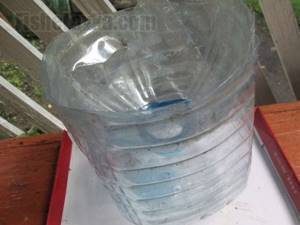
Photo 1. Small top from a plastic jar.
- If you need a can for catching bream from a boat, then the best option would be fishing on a medium and large river. Only during the current will the food be slowly washed out of the feeder, forming an attractive trail. Not only bream, but also roach, silver bream, and ide can be suitable for it. Species diversity will depend on the correct preparation of bait. It should be viscous and heavy enough to form a feeding path on the bottom without attracting hordes of bleak and perch.
- Catching catfish using can tackle is most often carried out in large reservoirs. Since this predator comes out of pits to feed, jars are installed at the entrances and exits of deep pools, as well as next to snags or thickets of grass. In addition to catfish, you can catch pike, pike-perch and perch with this tackle. If instead of live bait you attach peas, corn or boilies, then a large carp may also be hooked.
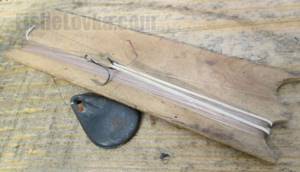
Photo 2. Equipment for a catfish can.
Closed feeder
This type of product is made when it is necessary to feed with worms or maggots. Here you can use any plastic container as a housing, be it a film or Kinder Surprise box.
A weighting agent is placed at the bottom of the product, the weight of which is selected depending on the level of the current. Holes are drilled in the walls of the structure, the diameter of which will be sufficient for the bait to gradually emerge into the wild.
The most resourceful fishermen resort to an alternative option, using a porous sponge as a replacement for the maggot container. It only takes a few minutes for the live bait to crawl inside and later crawl out of the material while at the bottom of the pond.
Baits and baits
When choosing bait, you should follow two simple rules. What's in the food is on the hook.
If you use a cut worm in bait, then place the same on the hook. This also applies to corn, pearl barley, and bloodworms.
Choose bait depending on the food supply of the reservoir. If mormysh live in large numbers in a reservoir, then this bait will be preferable.
And here's what you need to know: Review of the Maximus Marauder 662M spinning rod.
You can catch bream using: worms, maggots, bloodworms, jigs, corn, polystyrene foam, peas, pasta.
Bait should be selected depending on the fish you plan to catch. It should also be a bait that holds well on bottom hooks.
How to catch more fish? I have been active fishing for quite some time and have found many ways to improve the bite. And here are the most effective ones: Bite activator.
Attracts fish in cold and warm water with the help of pheromones included in the composition and stimulates its appetite. It is a pity that Rosprirodnadzor wants to impose a ban on its sale. More sensitive gear.
Reviews and instructions for other types of gear can be found on the pages of my website. Lures using pheromones.
You can get the rest of the secrets of successful fishing for free by reading my other materials on the site.
Some effective baits you can use are:
- worms;
- hominy;
- leeches;
- boilies;
- canned corn;
- mask;
- boiled hemp;
- steamed pearl barley;
- pearl barley shell.
For greater productivity, you can take several baits from this list when fishing.
What to fish with: baits and lures
Bait for bream can be a red worm, caster, maggot, dragonfly larva, etc. Also widely used, especially in summer, are baits: corn grains, lard, boilies, pasta, peas, etc. Fishermen often use a combined bait, so-called sandwiches.
For example, peas, a worm and a bread ball flavored with anise, or maggot with steamed pearl barley, or sweet corn with a worm. The general rule for choosing bait or bait is the following: each body of water has its own food supply. And they must be taken into account. Let's say if you observe a large number of bloodworms in the water, then it would be logical to try it as bait in such a place.
Another important rule: put on the hook something that has already been used for bait.
Now that we know what to catch, what and how to feed, let’s answer the main question.
Fishing technique
Choose a promising fishing spot. Prepare your gear and mix some complementary foods. Explore the bottom topography using an echo sounder or other available means. If you use tackle without a feeder, then feed the intended fishing area in advance. To do this, roll five or six balls of bait, aim, try to get them to fall into the water a little closer than the tackle will be.
This is explained by the fact that the bottom topography has the shape of a slide, and the lure is in the shape of a ball and rolls a little lower. Set the bait. Throw the tackle into the water and set the pecking indicator. Remember that under any conditions, you must throw one ball of bait every twenty minutes, regardless of whether you are biting or not. This is necessary to keep fish in the fishing area and attract new schools.
If you use tackle with a feeder, then preliminary feeding is not required. Place the bait in the feeder, adjusting the compression force depending on the speed of the current. The stronger the current, the more you need to compress the bait. You should check the availability of complementary foods every twenty to thirty minutes.
Attach the bait, cast, set the bite indicator. Next, when the indicator is triggered, hook immediately, do not wait for the fish to sit on your hook, this happens extremely rarely.
Hook with the rod, with a sharp, strong movement. Start catching fish.
Don't pull too fast or too slow. When reeling in quickly, the load on the rod and reel increases, the depreciation of the gear worsens, and with the next blow, the fish may break off.
If it’s slow, the fish can go into the grass, hide behind a snag, dive deeper into the hole, and most likely it will end in death. Always keep a landing net in a visible place; you should be able to reach it without difficulty; most landings occur just under the shore.
When the fish is on the shore, put it in the cage or release it. Check the presence of complementary food in the feeders, adjust the bait, and re-throw the tackle.
Features of catching carp on a feeder
When catching bream, you should take into account many features of its habits, which depend on the time of year and day. In the spring, before spawning, bream gathers in large schools and begins to actively feed.
The fisherman must be very careful, any noise can scare the fish. In the pre-spawning period, the main food for bream is insect larvae that are found in bushes and algae, so there is no need for long casts.
In summer, bream rolls into holes and moves closer to the fairway, so you need to look for it there. It comes out to the shallows and dumps to feed. In the fall, with the weather getting colder, the bream completely stops leaving its favorite habitats.
We've sorted out the equipment and installation options. We also decided on how best to prepare the bait. After all, a lot depends on her too. Now let's talk about how best to use gear with a feeder when fishing for carp. Let's start with what time of year is most suitable for such fishing.
Mostly carp are caught on a feeder in the summer. In spring and autumn, such tackle is less effective.
This is explained by the peculiarities of fish behavior. In the summer, carp are mostly active.
Tries to search for food regularly. Eats a lot.
Therefore, a feeder with aromatic bait often attracts him. In spring and autumn days the situation changes.
The feeding activity of carp is reduced. He spends more time in pits and various shelters.
Moreover, the fish react less to local feeding. Therefore, gear with feeders becomes less effective.
What else is important to remember? There are several points that significantly affect the effectiveness of catching carp on a feeder. Let's talk about them in more detail:
- You shouldn’t limit yourself to just bait in the feeder. This is not enough to attract carp. Be sure to feed the fishing spot.
- Baits and lures must meet the seasonal taste preferences of the fish. Typically, plant foods are more suitable for summer, and animal and protein foods are more suitable for spring and autumn. An excellent option is foam balls or boilies with positive buoyancy. This kind of bait in the water rises slightly above the bottom soil. As a result, it is easier for carp to both notice and swallow it.
- Fishing using equipment with a feeder is more effective if you have feeder gear. They are less sensitive to weak bites, allow you to make accurate and long-distance casts, are good for fishing, and much more. etc.
- Pay special attention to the fishing area. To do this, use a marker rod before fishing. It will help you identify more promising points where you should throw the bait.
General Tips
- If possible, do not skimp on gear; remember, high-quality gear, with good handling and care, will serve you for many years. Cheap and low-quality equipment can let you down at the most inopportune moment, ruining your fishing and your mood.
- Always choose fresh bait.
- Study the bottom topography in detail for any snags. It’s better to spend a couple of minutes preparing than to get into trouble at the most crucial moment.
- Do not use metal cages, as the fish hitting them scares other fish.
- Securely attach bite indicators to your rods. More than one thousand bells flew into the water and were irretrievably lost during a sharp cut.
- Keep quiet, bream is an extremely cautious fish.
- Do not use overly aromatic baits in cold water, this will only scare away the fish.
- Have a couple of working rigs, spare hooks, lines, feeders and sinkers in stock.
- Don’t use a large number of fishing rods at the same time, you’ll be chasing two birds with one stone... you know the rest.

